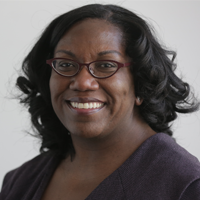Kristen Mack, Vice President, Communications, Fellows, and Partnerships, shares thinking on umbrella terms, which are intended to be inclusive but often come up short when discussing complex and evolving identities.
Umbrellas provide shade, shelter, and protection. They also serve as a symbol of power and dignity. Umbrella terms, as an extension, are designed to cover a broad category of groups. BIPOC and LGBTQ+, two of the most well-known and frequently used umbrella terms, have power. They also have limitations.
We have increasingly heard that the very thing these umbrella terms were designed to do—include more people under one broad categorization—has not worked. In fact, they have had the opposite intended effect. More people feel left out than included.

While the term Black, Indigenous, and People of Color (BIPOC) is meant to be inclusive, it is imperfect and imprecise. Although BIPOC includes Asian and Latino/a/x people as well as other racial and ethnic groups, the acronym does not resonate with everyone it was meant to embrace. We must acknowledge that many individuals and communities do not see themselves represented by the term because they are not specifically named. We have heard from people—repeatedly, vehemently, and clearly—that they are offended by its use.
We first received that feedback during several conversations with grantees, peers, and affinity-based philanthropic organizations as part of our Equitable Recovery grantmaking. We went through an extended exercise of identifying characteristics that define what it meant to be a BIPOC-led, -centered, or -serving organization. Around that time, we began to use the term more frequently in our writing and communication, just as the rest of the U.S. and field of philanthropy was doing the same.
While it became popularized recently, the first use of the term BIPOC can be traced back to 2013. BIPOC is an attempt to center the violence, systemic racism, and cultural erasure against Black and Indigenous people and how it is foundational to the United States, a country founded on the enslavement of Black people and the genocide of Indigenous people.
There are other, more inclusive umbrella options such as ALAANA, which stands for African, Latinx, Arab, Asian, or Native American. But it is less commonly used outside of the arts world. To be sure, the conversation about umbrella terms extends beyond racial and ethnic identities.
It has also taken place in the LGBTQ+ community around gender and sexuality. While the acronym is more widely used and accepted and has evolved over time to include Lesbian, Gay, Bisexual, Transgender, Queer or Questioning, Intersex, Asexual, the plus allows folks to flex and be more expansive. Still, there are other identities not named such as pansexual, nonbinary, and genderqueer. One inventive response has been MOGII, which means Marginalized Orientations, Gender Identities, and Intersex.
It addresses the many ways umbrella terms often come up short in referencing complex, evolving, and intersectional racial, ethnic, and gender identities. That is why we emphasize the importance of seeking and respecting self-identification in our Foundation’s asset-based language guidelines. We encourage Staff to be specific, precise, and descriptive.
It is a part of our commitment to continually refine our use of language to be as representative and inclusive as possible.
Admittedly, people are afraid of getting it “wrong” or using an imprecise term. We remind Staff that our asset-based guidelines are just that—guidelines, not rules—that are meant to give them the facility to understand their options, choices, and when and why they use certain words and language.
Certainly, if our peers, partners, or grantees are using phrases like BIPOC, that too is a choice we will respect. We realize language is fluid, and we will continue to review and revisit the terminology we use. As our partners at the Healthy Communities Foundation, have modeled and we seek to emulate, at the end of the day, we “remain committed to being in right relationship” with the communities we seek to serve.
MacArthur is a learning organization. As the lexicon evolves, we will continue to actively seek new understanding and knowledge and apply what we learn as we go.
Language conveys values. Language can be used to either support or challenge the systems we seek to dismantle. We want people to see themselves in the language we use—in our website copy, at our events, in our grantmaking, and in our work.
We hope that by consciously and intentionally focusing on our language that we are affirming the dignity of the people and communities we serve.
Related Article
Capitalizing Black and White: Grammatical Justice and Equity ›



